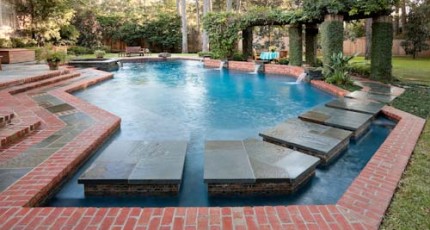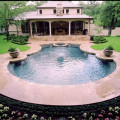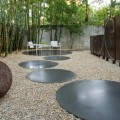Swimming Pool Coping

Pool coping is a masonry product that sits on top of the pool beam structure. It sits partly on the edge of the swimming pool shell, and it rises above the patio or deck. It is also one of the most important structures in swimming pool design because it provides transitional space between the patio proper and the surface of the water.
People like to sit on pool coping and dangle their feet in the water. Others prefer to stand on its edge at night and peer over into the depths of water illuminated by underwater lights. Its horizontal surface area can be either very thick or very thin, but it must always be sufficiently strong to support the full weight of the human body due to the tendency of people to use it as a support structure.
Pool coping is one of those hardscape designs where the landscape designer has a great deal of creative freedom. It can be made from almost any material. Common materials that are used around pools of all shapes and sizes include slate, travertine, concrete, brick, and stone. Material choices are based upon pool style, patio or deck construction, and aesthetic compliment to home architecture.
In one of our more unique projects, a couple in River Oaks requested that we not build a patio at all, but simply build a concrete coping around the pool that would separate the water from the lawn. This simple design proved to be one of the more interesting landscape features we ever created. We nicknamed this work our Grass Pool Patio Project, and it has become one of our more famous creations here in the Houston area.
Luxury pool coping is most often constructed from either travertine or limestone. Both of these stone types have been used since Ancient times to build massive structures, and the degree of sophistication they add to residential architecture and landscape design cannot be understated. Both travertine and limestone appear amazingly refined when polished, and they work well with a number of home architectural styles—particularly Italian and Mediterranean.
Not only is the choice of material important here, but the texture of the material is also significant to the overall success of the aesthetic. How the material is formed into coping will play a major role in how the finished product appears. If it has been sawn, it will appear segmented. If the surface has been honed, it will have a more contiguous look.
Finishing and polishing are also essential to quality pool coping construction. Adding a thermal finish (by heating the material with a flame) will make the surface appear slightly pebbled. Polishing the surface can make certain materials so reflective that they will literally surround the water with glints of light. Still other materials can be chiseled to create a more rugged and natural look more appropriate to landscapes that place a greater emphasis on natural forms and softscape elements.
Without exception, pool coping is a major component in every pool renovation projects. It is one of the most significant aspects of swimming pool design because it is not always possible to raise or lower a pool shell or deck. Adjusting the coping, on the other hand, can change the perceived elevation of the pool and add a whole new look and feel to the patio.
Pool coping can be the keynote to your custom patio design as well if you have it done by a professional landscaping company who knows what they are doing. Much more than a simple boundary around the perimeter of the water, coping rises up to establish presence, geometric form, color, and style as a prominent work of elegance in backyard landscape design.





